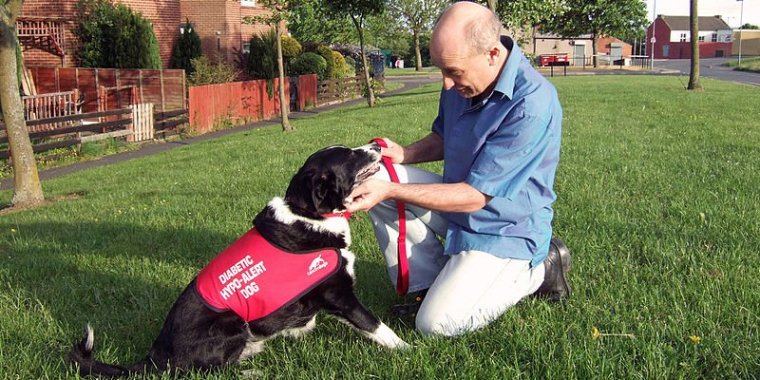| News / Science News |
The Dog's Nose Knows Malaria
Freya's ability to sense the deadly disease is tested in a plain white room. Her handler hides behind opaque one-way glass. At his signal, Freya darts across the lab room floor and sniffs a collection of small open mason jars. Each is holding a sock worn by a young child in Ghana for one night only. In less than 10 seconds, Freya stops sniffing and sits down in front of a jar.

Hypo alert dog Tinker and his owner. ![]()
That means she has a hit, and in a new study published Monday, researchers from Durham University in England say Freya can sniff out malaria with 70 percent accuracy. And that could be a game changer.
The fight against malaria has been long and challenging. The mosquito-borne illness killed over 400,000 in 2015, according the most recent statistics from the World Health Organization. Slowly but steadily, the world has made progress against the disease. Since 2010, malaria mortality rates have dropped 29 percent, again according to the WHO. And just recently, the South American country of Paraguay was certified to be malaria-free.
And that's where Freya might play a huge role. Lead investigator Steve Lindsay says he got the idea for training dogs to sniff out malaria after a visit overseas, when he saw dogs sniffing for all kinds of contraband.
"People with malaria smell differently," Lindsay told VOA, so he thought, why not see if dogs could detect tiny traces of the disease.
Lindsay sees a future where malaria-sniffing dogs greet travelers at ports of entry, helping medical personnel sniff out infected travelers. Another potential application would be for countries that are just about to eliminate the disease.
"If you're trying to find that last few hot spots," Lindsay says, "rather than screening everyone, the dogs might be good enough to go into the villages to find people." That could save money, time and lives.
Freya was trained by a non-profit group called Medical Detection Dogs. Lindsay points out that dogs are already being used to sniff out diseases like "cancers, and Parkinson's disease. And they actually have alert dogs that work with diabetic patients" that can tell when a patient is going into hypoglycemia.
Lindsay also sees the possibility that dogs like Freya could sniff out a host of other infectious diseases. He cautions that the research is still in its early stages but is excited about the possibility of expanding his research.
Another question: if dogs can do it, can we build a nose that does it better? Lindsay says the team from Medical Detection Dogs is working with the Massachusetts Institute of Technology (MIT) to develop what he calls an e-nose.
But he says any useful kind of e-nose is at least "five to 10 years" away, because while Lindsay says the e-noses are about as good as ours, "they're not as good as a dog's nose which is anywhere from 10,000 to 100,000 times as acute as our own."
If this research holds up, we could see a future in which dogs are sniffing out diseases, as well as drugs and contraband all over the world. (Kevin Enochs/VOA)
YOU MAY ALSO LIKE





